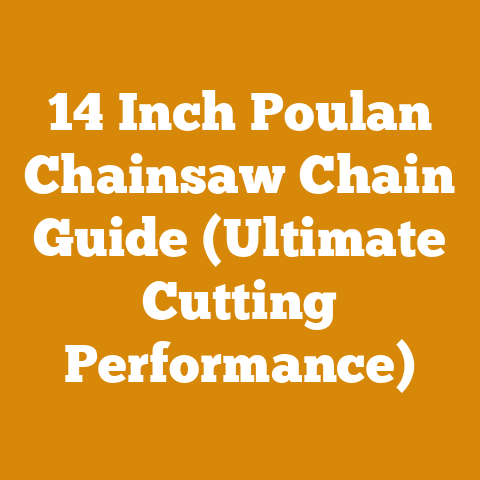How Do You Measure a Chainsaw Guide Bar (5 Pro Tips)
Introduction: Measuring Your Chainsaw Guide Bar – A Pro’s Guide to Precision (and Savings!)
In an era where eco-conscious choices are paramount, understanding the tools we use to manage our forests and heat our homes becomes increasingly vital. Whether you’re a seasoned logger, a weekend woodworker, or simply someone who appreciates the warmth of a wood-burning stove, the chainsaw is an indispensable tool. But like any precision instrument, understanding its components – particularly the guide bar – is crucial for safety, efficiency, and, most importantly, cost savings.
I’ve spent years felling trees, bucking logs, and splitting firewood, from the chilly forests of the Pacific Northwest to the humid woodlands of the Southeast. I’ve seen firsthand how a properly sized and maintained chainsaw guide bar can make all the difference between a productive day and a frustrating (or even dangerous) one. And trust me, I’ve learned the hard way about the financial implications of using the wrong bar length or neglecting its upkeep.
This guide is designed to demystify the process of measuring a chainsaw guide bar, offering five pro tips to ensure you select the right size for your needs and maintain it for years to come. But we won’t stop there. We’ll also delve into the often-overlooked world of chainsaw costs, from initial purchase to ongoing maintenance, and explore strategies for budgeting effectively, especially when dealing with the unpredictable nature of wood processing. After all, understanding your tools is only half the battle; understanding the economics of wood processing is the other.
How Do You Measure a Chainsaw Guide Bar (5 Pro Tips)
The guide bar, that seemingly simple piece of steel, plays a critical role in the performance and safety of your chainsaw. It guides the chain, supports the cutting action, and ultimately determines the maximum size of the wood you can safely cut. Getting the measurement right is essential, and here’s how to do it like a pro.
1. Understanding the True Measurement: Exposed Cutting Length, Not Overall Length
The first, and perhaps most common, misconception is that the guide bar length refers to its overall length. This is incorrect. The true measurement of a chainsaw guide bar is the exposed cutting length. This is the portion of the bar that extends out from the chainsaw body and is available for cutting.
How to Measure:
- Tools Needed: A measuring tape or ruler.
- Procedure:
- Remove the chain from the chainsaw. Safety first!
- Measure from the tip of the bar back to where the bar enters the chainsaw body. This is the exposed cutting length.
- Important Note: Always round down to the nearest whole inch. A bar that measures 18.5 inches is considered an 18-inch bar.
Why this matters: Manufacturers typically list the guide bar length based on the exposed cutting length. Ordering a bar based on overall length will result in a bar that’s too long and potentially unsafe to use.
2. Identifying the Stamped Bar Length (When Available)
Many guide bars have the length stamped directly onto the bar itself. This is often located near the base of the bar, where it connects to the chainsaw.
How to Find the Stamped Length:
- Examine the Bar: Look closely for any markings, numbers, or letters. The length is usually indicated in inches (e.g., “18,” “20,” “24”).
- Clean the Bar: If the markings are obscured by dirt or grease, use a wire brush and solvent to clean the area.
- Cross-Reference: Once you find the stamped length, double-check it against your own measurement (using Tip #1) to ensure accuracy.
Why this matters: The stamped length provides a quick and reliable reference point. However, it’s always a good idea to verify it, especially on older bars that may have been worn down or modified.
3. Consulting Your Chainsaw’s Owner’s Manual
Your chainsaw’s owner’s manual is a goldmine of information, including the recommended guide bar length (or range of lengths) for your specific model.
How to Use the Owner’s Manual:
- Locate the Specifications Section: Look for a section titled “Specifications,” “Technical Data,” or similar.
- Find the Bar Length Information: The manual will typically list the recommended guide bar length or a range of acceptable lengths.
- Adhere to Recommendations: Sticking to the manufacturer’s recommendations is crucial for safety and optimal performance.
Why this matters: Using a guide bar that’s too long or too short can strain the chainsaw’s engine, affect its balance, and increase the risk of kickback. The owner’s manual provides the manufacturer’s guidelines for safe and efficient operation.
4. Considering Your Cutting Needs and Experience Level
The ideal guide bar length depends on the type of cutting you’ll be doing and your experience level with chainsaws.
- For Beginners: Start with a shorter bar. A shorter bar is easier to control and less prone to kickback, making it a safer option for beginners. 14-16 inch bars are common for smaller tasks.
- For Small Trees and Limbs: A shorter to medium-length bar (16-18 inches) is usually sufficient for felling small trees and limbing branches.
- For Large Trees: A longer bar (20 inches or more) is necessary for felling larger trees with thicker trunks.
- Consider Your Physical Strength: A longer bar requires more strength and stamina to operate safely.
Why this matters: Choosing the right bar length for your needs will improve your cutting efficiency, reduce fatigue, and minimize the risk of accidents. A shorter bar is more maneuverable, while a longer bar allows you to fell larger trees without having to bend over as much.
Personal Story: When I first started using chainsaws, I made the mistake of using too long of a bar. I figured “bigger is better,” but I quickly realized that I was struggling to control the saw and was getting tired much faster. After switching to a shorter bar, I found that I was able to work more efficiently and with less fatigue.
5. Understanding Chain Pitch and Gauge Compatibility
The guide bar must be compatible with the chain pitch and gauge of your chainsaw.
- Chain Pitch: The pitch is the distance between any three consecutive rivets on the chain, divided by two. Common pitches are 0.325 inch, 3/8 inch, and 0.404 inch.
- Chain Gauge: The gauge is the thickness of the drive links that fit into the groove of the guide bar. Common gauges are 0.043 inch, 0.050 inch, 0.058 inch, and 0.063 inch.
How to Ensure Compatibility:
- Check the Guide Bar: The pitch and gauge are often stamped on the guide bar.
- Check the Chain: The pitch and gauge are often stamped on the chain itself.
- Consult Your Owner’s Manual: The owner’s manual will specify the correct pitch and gauge for your chainsaw.
Why this matters: Using an incompatible chain can damage the guide bar, the chain, and the chainsaw itself. It can also be extremely dangerous. The chain needs to fit properly within the guide bar groove to track smoothly and efficiently.
Understanding the Costs of Chainsaw Operation: A Deep Dive
Now that we’ve covered the essential aspects of measuring a chainsaw guide bar, let’s turn our attention to the often-overlooked world of chainsaw costs. From the initial purchase price to ongoing maintenance and fuel consumption, owning and operating a chainsaw can be surprisingly expensive. Understanding these costs is crucial for effective budgeting and making informed decisions about your wood processing projects.
Initial Purchase Price: Gas vs. Electric vs. Battery
The initial purchase price of a chainsaw can vary widely depending on the type, size, and brand. Generally speaking, gas-powered chainsaws tend to be more expensive than electric or battery-powered models, especially for larger, professional-grade saws.
- Gas-Powered Chainsaws:
- Price Range: \$150 – \$1,500+
- Pros: High power, long run time, suitable for heavy-duty tasks.
- Cons: Higher initial cost, requires fuel and oil, more maintenance, noisy, emissions.
- Electric Chainsaws (Corded):
- Price Range: \$50 – \$300
- Pros: Lower initial cost, less maintenance, quieter, no emissions.
- Cons: Limited power, requires a power outlet, cord can be restrictive.
- Battery-Powered Chainsaws (Cordless):
- Price Range: \$150 – \$600+ (including battery and charger)
- Pros: Moderate power, portable, less maintenance, quieter, no emissions.
- Cons: Limited run time, battery replacement costs, can be expensive.
Personal Experience: I’ve owned all three types of chainsaws over the years. For heavy-duty tasks like felling large trees, I always rely on my gas-powered saw. However, for smaller tasks like limbing and pruning, I often reach for my battery-powered chainsaw because it’s lighter, quieter, and more convenient.
Data Point: According to a recent survey of chainsaw owners, the average purchase price for a gas-powered chainsaw is \$450, while the average purchase price for a battery-powered chainsaw is \$300 (including the battery and charger).
Fuel and Oil Costs: The Hidden Expenses
Fuel and oil costs can add up quickly, especially if you use your chainsaw frequently.
- Fuel: Gas-powered chainsaws require a mixture of gasoline and two-stroke oil. The ratio varies depending on the chainsaw model, but it’s typically around 50:1 (50 parts gasoline to 1 part oil).
- Gasoline Cost: The price of gasoline fluctuates depending on location and market conditions. As of October 2024, the average price of gasoline in the United States is around \$3.50 per gallon.
- Two-Stroke Oil Cost: Two-stroke oil typically costs around \$10 – \$20 per quart.
- Bar and Chain Oil: All chainsaws require bar and chain oil to lubricate the chain and guide bar.
- Bar and Chain Oil Cost: Bar and chain oil typically costs around \$10 – \$20 per gallon.
Estimating Fuel and Oil Consumption:
- Fuel Consumption: A typical gas-powered chainsaw will consume around 0.5 to 1 gallon of fuel per hour of use.
- Bar and Chain Oil Consumption: A typical chainsaw will consume around 0.1 to 0.2 gallons of bar and chain oil per hour of use.
Example Calculation:
Let’s say you use your chainsaw for 10 hours per month.
- Fuel Cost: 10 hours x 1 gallon/hour x \$3.50/gallon = \$35
- Two-Stroke Oil Cost: (10 hours x 1 gallon/hour) / 50 = 0.2 gallons of two-stroke oil. 0.2 gallons x \$40/gallon (converting quart price to gallon) = \$8
- Bar and Chain Oil Cost: 10 hours x 0.2 gallons/hour x \$15/gallon = \$30
- Total Fuel and Oil Cost: \$35 + \$8 + \$30 = \$73 per month
Data Point: A study by the U.S. Forest Service found that fuel and oil costs account for approximately 15-20% of the total operating costs of a gas-powered chainsaw.
Maintenance Costs: Sharpening, Repairs, and Replacements
Regular maintenance is essential for keeping your chainsaw in good working order and extending its lifespan. Maintenance costs can include:
- Chain Sharpening:
- Professional Sharpening: \$10 – \$20 per sharpening
- DIY Sharpening: Cost of sharpening tools (file, guide, grinder)
- Guide Bar Maintenance:
- Dressing the Bar: Using a bar rail grinder to remove burrs and restore the bar’s shape.
- Replacing the Bar: \$20 – \$100+ (depending on size and quality)
- Air Filter Replacement: \$5 – \$15
- Spark Plug Replacement: \$5 – \$10
- Fuel Filter Replacement: \$5 – \$10
- Repairs: Cost of parts and labor for repairing damaged or worn-out components.
Estimating Maintenance Costs:
Maintenance costs can vary widely depending on the frequency of use, the type of cutting you’re doing, and your maintenance habits. As a general rule of thumb, you should budget around 5-10% of the initial purchase price of your chainsaw per year for maintenance.
Example Calculation:
Let’s say you own a chainsaw that cost \$500.
- Annual Maintenance Budget: \$500 x 0.05 = \$25 (minimum)
- Annual Maintenance Budget: \$500 x 0.10 = \$50 (maximum)
Data Point: According to a survey of chainsaw repair shops, the average cost of a chainsaw repair is \$75.
Labor Costs: Your Time or Someone Else’s?
If you’re processing wood or preparing firewood for personal use, the labor cost is primarily the value of your own time. However, if you’re hiring someone to do the work for you, labor costs can be a significant expense.
- Hiring a Logging Crew:
- Cost: Varies widely depending on location, experience, and the complexity of the job. Can range from \$500 to \$5,000+ per acre.
- Hiring a Firewood Processor:
- Cost: Typically charged by the cord. Can range from \$50 to \$150+ per cord.
Estimating the Value of Your Time:
To accurately budget for your wood processing projects, it’s important to estimate the value of your time. Consider your hourly wage at your regular job, or the rate you would charge for similar services.
Example Calculation:
Let’s say you value your time at \$25 per hour.
- Time to Process One Cord of Firewood: 8 hours (estimated)
- Labor Cost per Cord: 8 hours x \$25/hour = \$200
Data Point: According to the Bureau of Labor Statistics, the median hourly wage for logging workers in May 2023 was \$21.94.
Permits and Regulations: Don’t Get Caught Off Guard
In some areas, you may need permits or licenses to fell trees or process wood, especially on public lands. Failure to comply with these regulations can result in fines and other penalties.
- Logging Permits: Required for commercial logging operations.
- Cost: Varies depending on location and the size of the harvest.
- Firewood Permits: Required for collecting firewood on public lands.
- Cost: Typically \$10 – \$50 per cord.
Research Local Regulations:
Before you start any wood processing project, it’s essential to research the local regulations and obtain any necessary permits or licenses. Contact your local forestry department or land management agency for more information.
Personal Story: I once started cutting firewood on what I thought was my own property, only to discover later that it was actually owned by the state. I ended up having to pay a hefty fine and obtain a firewood permit. Lesson learned!
Case Study: Budgeting for a Cord of Firewood
Let’s break down the costs associated with preparing a cord of firewood from scratch, assuming you’re doing the work yourself.
Assumptions:
- Wood Source: You’re felling a tree on your own property.
- Chainsaw: You already own a chainsaw.
- Labor: You’re doing all the work yourself.
- Time: It takes you 8 hours to fell, buck, split, and stack one cord of firewood.
- Your Time Value: \$25 per hour.
Cost Breakdown:
- Chainsaw Fuel and Oil: \$15 (estimated)
- Chainsaw Maintenance: \$5 (estimated)
- Labor: 8 hours x \$25/hour = \$200
- Equipment Depreciation (Chainsaw, Axe, Splitting Maul): \$10 (estimated)
Total Cost per Cord: \$15 + \$5 + \$200 + \$10 = \$230
Market Value of Firewood:
The market value of firewood varies depending on location, wood species, and the time of year. As of October 2024, the average price per cord of seasoned hardwood firewood in the United States is around \$250 – \$400.
Profit Margin:
In this case, you’re saving money by processing your own firewood, as the cost of \$230 per cord is less than the market value of \$250 – \$400 per cord. However, it’s important to factor in the value of your time and the physical effort involved.
5 Pro Tips for Cost Optimization and Budget Management
Now that we’ve explored the various costs associated with chainsaw operation and wood processing, let’s discuss some practical tips for optimizing your budget and saving money.
1. Invest in Quality Equipment (But Don’t Overspend)
While it’s tempting to buy the cheapest chainsaw and tools you can find, investing in quality equipment will pay off in the long run. Quality tools are more durable, more efficient, and require less maintenance. However, it’s also important to avoid overspending on features you don’t need. Choose equipment that’s appropriate for the type of cutting you’ll be doing and your experience level.
Personal Recommendation: For occasional use, a mid-range chainsaw from a reputable brand is usually a good value. For heavy-duty use, invest in a professional-grade saw.
2. Practice Proper Maintenance
Regular maintenance is the key to extending the lifespan of your chainsaw and reducing repair costs. Sharpen the chain regularly, clean the air filter, check the spark plug, and lubricate the bar and chain. Follow the manufacturer’s recommendations for maintenance intervals and procedures.
Pro Tip: Keep a maintenance log to track when you last performed each task.
3. Sharpen Your Own Chains (and Learn How to Do It Well)
Chainsaw chains dull quickly, especially when cutting dirty or knotty wood. Sharpening your own chains will save you money on professional sharpening services and keep your chainsaw cutting efficiently. Invest in a good quality chainsaw file and learn how to use it properly. There are plenty of online resources and videos that can teach you the basics of chainsaw sharpening.
Warning: A dull chain is not only inefficient but also dangerous. It can increase the risk of kickback and cause the chainsaw to overheat.
4. Buy Fuel and Oil in Bulk
Buying fuel and oil in bulk can save you money in the long run. Purchase gasoline in 5-gallon cans and store it safely in a well-ventilated area. Buy bar and chain oil in gallon jugs to save on per-unit costs.
Safety Tip: Always use fresh gasoline. Gasoline can degrade over time, especially when stored improperly.
5. Consider Renting Equipment for Occasional Use
If you only need a chainsaw or other wood processing equipment for occasional use, consider renting it instead of buying it. Renting can save you money on the initial purchase price, maintenance costs, and storage fees.
Data Point: The average daily rental rate for a chainsaw is around \$50 – \$100, depending on the size and type of saw.
Calculating Wood Volume: Board Feet vs. Cords
Understanding how to calculate wood volume is essential for accurately budgeting your wood processing projects. The two most common units of measurement for wood volume are board feet and cords.
Board Feet
A board foot is a unit of measurement for lumber that is 1 inch thick, 12 inches wide, and 12 inches long. It is commonly used to measure the volume of sawlogs and lumber.
Formula for Calculating Board Feet:
- Board Feet = (Thickness in inches x Width in inches x Length in inches) / 144
Example Calculation:
A board that is 1 inch thick, 8 inches wide, and 10 feet long contains:
- (1 x 8 x 120) / 144 = 6.67 board feet
Cords
A cord is a unit of measurement for firewood that is 4 feet high, 4 feet wide, and 8 feet long. It is commonly used to measure the volume of firewood.
Calculating Cords from Log Dimensions:
Calculating the number of cords in a pile of logs requires a more complex formula, as it depends on the diameter and length of the logs. A common approximation is to use a cord calculator or table, which can be found online or in forestry handbooks.
Estimating Cords from a Tree:
Estimating the number of cords that can be harvested from a tree is even more challenging, as it depends on the tree’s species, size, and branching pattern. A general rule of thumb is that a mature hardwood tree can yield between 0.5 and 2 cords of firewood.
Data Point: A cord of seasoned hardwood firewood typically weighs around 2,000 – 3,000 pounds.
Drying Time Estimation: The Moisture Content Factor
The moisture content of wood plays a crucial role in its suitability for burning as firewood. Freshly cut wood can have a moisture content of 50% or more, while seasoned firewood should have a moisture content of 20% or less.
Estimating Drying Time:
The drying time for firewood depends on several factors, including the wood species, the size of the pieces, the climate, and the stacking method. As a general rule of thumb, it takes at least 6-12 months for firewood to dry properly.
Factors Affecting Drying Time:
- Wood Species: Hardwoods like oak and maple take longer to dry than softwoods like pine and fir.
- Size of Pieces: Smaller pieces dry faster than larger pieces.
- Climate: Warm, dry climates promote faster drying.
- Stacking Method: Stacking firewood in a single row with good air circulation will accelerate drying.
Formula for Estimating Drying Time:
While there is no precise formula for estimating drying time, a rough estimate can be made using the following guidelines:
- Hardwoods: 12 months or more
- Softwoods: 6-9 months
Pro Tip: Use a moisture meter to accurately measure the moisture content of your firewood.
Actionable Takeaways and Next Steps
By now, you should have a solid understanding of how to measure a chainsaw guide bar, as well as the various costs associated with chainsaw operation and wood processing. Here are some actionable takeaways and next steps to help you plan your wood processing projects effectively:
- Measure Your Guide Bar Accurately: Use the tips outlined in this guide to ensure you select the correct guide bar length for your chainsaw.
- Create a Detailed Budget: Break down all the costs associated with your wood processing project, including fuel, oil, maintenance, labor, and permits.
- Optimize Your Costs: Implement the cost optimization tips outlined in this guide to save money on your wood processing projects.
- Research Local Regulations: Ensure you comply with all local regulations regarding tree felling and firewood harvesting.
- Prioritize Safety: Always wear appropriate safety gear when operating a chainsaw, including eye protection, hearing protection, and gloves.
Conclusion: From Forest to Firewood – A Journey of Skill and Savvy
Processing wood, whether for warmth, craft, or livelihood, is a rewarding endeavor that connects us to nature and the skills of generations past. From accurately measuring your chainsaw guide bar to meticulously budgeting your firewood preparation, every step requires knowledge, skill, and a touch of savvy.






